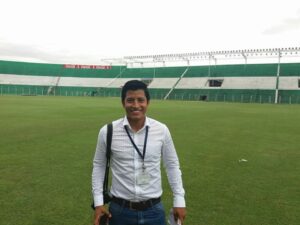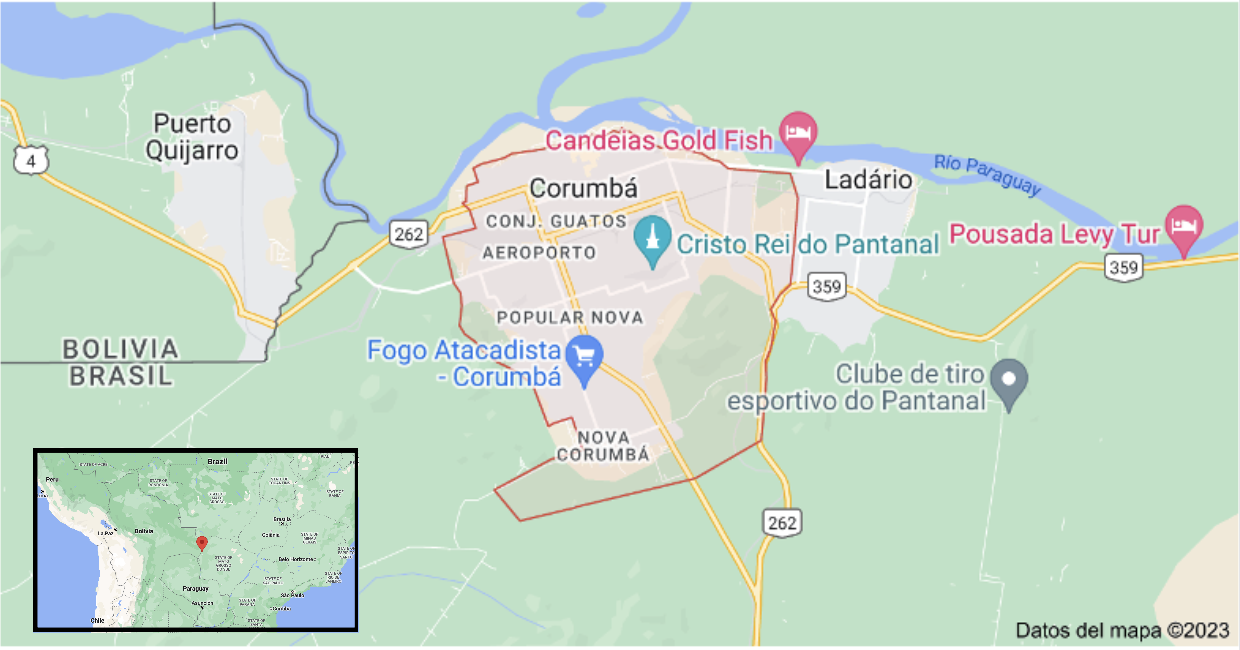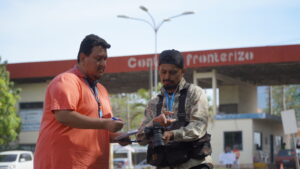In November 2019, Pedro Montenegro was extradited to Brazil for the crime of cocaine trafficking. He was one of the most wanted men in Bolivia. The journalistic coverage of his transfer to the city of Corumbá, bordering Puerto Quijarro (Bolivia), brought together Leonardo Cabral of Diário Corumbaense (Brazil) and Ariel Melgar Cabrera of El Deber (Bolivia) to collaborate in their coverage in that region.
Given the immediacy of the facts related to drug trafficking by land, the passage of migrants and the variability in this area, Cabral and Melgar Cabrera exchanged sources, data on arrests and drug trafficking and even helped each other with translations. "Being a journalist on the border means collaborating and partnering with others because we need each other," Cabral told LatAm Journalism Review (LJR).

Journalist Ariel Melgar Cabrera of El Deber newspaper, in Bolivia. (Photo credit: Courtesy)
Ariel Melgar Cabrera of El Deber reinforced this idea of collaboration with an anecdote: "I remember that in order to report to the Federal Police of Brazil, I asked Leonardo [Cabral] for help. From that moment on, he became a reliable source in the field to ask [for information]," he added in a telephone interview from the city of Santa Cruz de la Sierra.
El Deber is the newspaper with the largest circulation in Bolivia. Its website receives close to 30 million unique visitors a year. "It’s independent, it’s not state-owned and all the news is impartial," Melgar Cabrera said. While the printed version of Diário Corumbaense is distributed locally (in the municipalities of Corumbá, Ladário and the Pantanal region). And about 20 thousand people read it online on a daily basis. "It’s remarkable how in the social media of Diário Corumbaense we receive comments from Bolivian citizens", Cabral said.
Corumbá’s territory shares borders with Bolivia and also with Paraguay, which makes Corumbá - in the marshland region of Mato Grosso do Sul - one of the ten "bi-border" municipalities in Brazil. According to sources from the Brazilian Federal Revenue Service who spoke to LJR, some 6,000 people and 3,000 vehicles circulate daily through the crossing between that city and Puerto Quijarro. “It’s an area of relevant situations common to both countries: What would happen if we did not have an immediate and reliable source such as the Diário Corumbaense in the region?," asked Bolivian journalist Melgar Cabrera.
Doing journalism in border areas requires handling various codes and a sharp eye. This led Melgar Cabrera and Cabral to support each other when interviewing their respective federal police on drug and drug trafficking issues. Another case that shook the region at the beginning of 2023 was that of Ruddy Sandoval, a 37-year-old Bolivian linked to drug trafficking and political figures in that country, who was found dead in an abandoned car in the city of Corumbá. On that occasion, El Deber published the news citing Diário Corumbaense as a source.

Corumbá, which belongs to the state of Mato Grosso do Sul (Brazil), shares border with the city of Puerto Quijarro (Bolivia). (Photo: Google Maps)
Network collaboration is one of the characteristics of contemporary and Latin American journalism. According to Adriana Amado, the media and communication researcher, these ways of working are a sort of "choral journalism," a concept she mentioned in her book "Journalism metaphors: Mutations and challenges." Although there is no explicit contract between the two journalists from Brazil and Bolivia, there is a flow and agreement to share sources and contacts.
Lucas Lélis, another reporter in Corumbá, who works for TV Morena (affiliated to TV Globo) said: "There is a peculiarity in doing journalism in the interior [of the country], which is very different from big urban centers where there are more press officers and the work is more individual. In the interior, if we don't help each other, we don't get anything done," he said.
Informing the community as a service is a concept that researcher Adriana Amado develops and defends for journalism in the 21st century. "Journalists are service providers to their community, from sports, the public sphere, to health. They are considered marginal subjects, but they are contents we should provide," Amado said in an interview published in LJR. Diário Corumbaense has sections that serve the local community in different areas such as: Tourism, Citizenship and Services (such as Health and Education).
Binational identity is also part of its journalistic mission. "We are a border city and in Diário Corumbaense we try to bring the cultures of Brazil and Bolivia closer together to unite us more by our traditions," said journalist Cabral, a Brazilian with a Bolivian mother. He mentioned the example of the feast of the Virgin Mary of Urkupiña, which is celebrated in more than 20 cities in Bolivia. Including a mass and a small folkloric entrance, it is also present in processions in the Brazilian city of Corumbá.
In June 2023, the traditional festivities in Junín gained space in the printed pages and the website of this local newspaper. "Festeiros banham São João e renovam fé e devoção nas águas do rio Paraguai [Festival-goers bathe São João and renew faith and devotion in the waters of the Paraguay River]," is the title of a story written in the crónica style (this past June 24) about the popular procession that carried the saint São João in a procession to the Paraguay River. The inhabitants of Corumbá paid homage to the saint and bathed him in a symbolic gesture of blessings. "It’s one of the most popular manifestations of central-west Brazil and has been recognized as Intangible Heritage since 2021. It seems important to us to mark it in our community, which also includes Bolivian citizens," Cabral said.

Leonardo Cabral and Anderson Gallo preparing for an interview at the Brazil-Bolivia border point 2 (Photo credit: Anderson Gallo and Leonardo Amaral, Diário Corumbaense)
Diário Corumbaense's newsroom is located in the downtown area of the city. This part of Corumbá, not far from the Paraguay River, still has the air of a countryside neighborhood, with long streets, stores and buildings in modern style. Some small houses sport colonial architecture. In front of the editorial offices, at siesta time there is almost no movement of people or transport. The neighbors retreat because of the heat and the sun radiating more than 30 degrees [86 Fahrenheit]. Next to the room where the three journalists of the Diário Corumbaense work, there is a huge press where the 1,500 weekly copies are printed and sold for R $1.00 (US $0.2) every Thursday.
Public credibility and journalistic ethics are vital to the success of journalism. Luiz Julião Rocha is 39 years old and lives in Corumbá, where he works in tourism. "Diário Corumbaense writes with a wealth of details. This can be felt in the precision of the information, in their texts," he said.
For his part, Cabral recalls one of the comments that made him and his colleagues in the editorial office most proud. "Once, on the occasion of an interview I conducted with a military commander of the region, at the end, she told me the only news she believed were true were those published in Diário Corumbaense," he said.
The newspaper is sustained through advertising by regular clients and others that support the newspaper on a temporary basis. "Sixteen years ago, when we established the newspaper, it was only distributed in points of sale until it migrated to online. Today we print it only once a week and we have advertising space," said Rosana Nunes, the director who founded Diário Corumbaense.
We live in a world in which stories disappear in a matter of seconds and fleeting stories abound online. In this sense, Diário Corumbaense makes a difference in the eyes of its readers. "In this newspaper, the news acquires a dynamic and local rhythm that is based on a constant dialogue with the concerns and interests of our community," said [Julião] Rocha, one of the newspaper's readers.
--
Contributor Soledad Dominguez is a journalist covering and writing stories on human rights, racial equality and innovation in journalism in Argentina and Brazil.